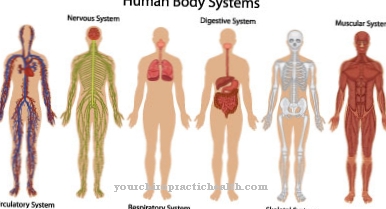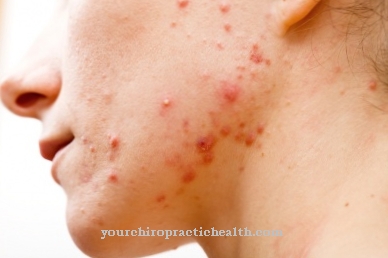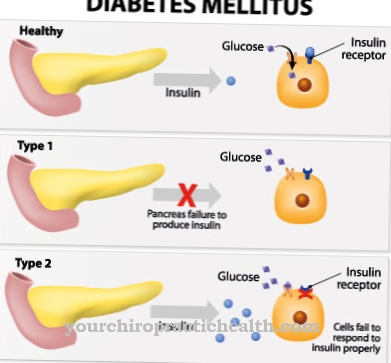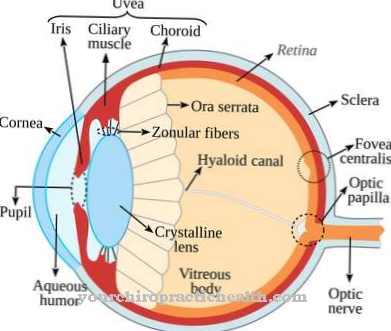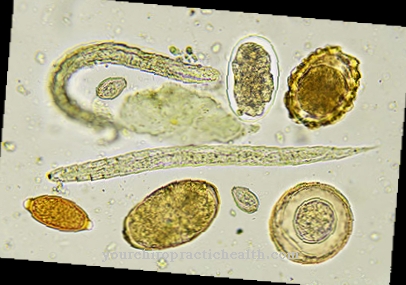The Dubin-Johnson Syndrome is an inherited disease that affects the liver primarily. Symptoms include jaundice, increased levels of bilirubin in the blood, and abnormalities in the liver. A causal treatment is not possible, but in most cases it is not necessary either.
What is Dubin-Johnson Syndrome?

© Peter Hermes Furian - stock.adobe.com
Dubin-Johnson syndrome belongs to the metabolic diseases and is subordinate to the group of disorders of bilirubin metabolism. The pathologist Isidore N. Dubin and the military doctor and pathologist Frank B. Johnson gave the syndrome its name. The two researchers were the first to describe this clinical picture in 1954.
The Dubin-Johnson syndrome mainly affects the liver, which is responsible for the development of the individual symptoms. The mutation that causes Dubin-Johnson syndrome is on one of the autosomes, that is, not on the X or Y chromosome. However, more women than men suffer from this hereditary disease. In humans, each chromosome exists twice.
The disease is recessive: if a person has a 10th chromosome with the mutation and a 10th chromosome without it, Dubin-Johnson syndrome does not break out. Only when two mutated chromosomes come together does the person become ill. This fact contributes to the fact that the disease is very rare. The carrier of a mutated chromosome can still inherit the syndrome if he passes the mutated chromosome on to his child and at the same time the child receives a disease-bearing chromosome from the other parent.
causes
A change in the genetic make-up is responsible for Dubin-Johnson syndrome. The mutation leads to more bilirubin reaching the bile. Bilirubin is a yellow pigment and is found in the blood. There it forms part of hemoglobin, the red pigment in the blood. The bilirubin can appear as direct (conjugated) or indirect bilirubin in the human body.
The direct bilirubin has a glucuronic acid molecule. Glucuronic acid increases the water solubility of biochemical substances. The organism cleanses the blood in the liver and spleen. In this process, the organs filter out blood components that are damaged and therefore need to be renewed. The increased water solubility due to glucuronic acid helps the body to excrete these rejected substances.
In Dubin-Johnson syndrome, this process is disturbed. The body does not dispose of the direct bilirubin sufficiently, but passes it on into the blood - which triggers the typical symptoms of the hereditary disease.
You can find your medication here
➔ Medicines for jaundice and liver problemsSymptoms, ailments & signs
An externally easily recognizable syndrome is jaundice (jaundice), which from childhood onwards turns the skin and eyeball yellow. A component of the blood called bilirubin is responsible for the color. Bilirubin is produced when the human body breaks down blood. Normally, the substance is only present in small quantities and therefore does not trigger a yellow color.
However, people who suffer from Dubin-Johnson syndrome or who develop jaundice for other reasons have too much bilirubin: the usual breakdown and disposal mechanisms fail. Along with jaundice, bile congestion (cholestasis) often occurs. Jaundice in Dubin-Johnson syndrome is often characterized precisely by the fact that no biliary congestion forms.
In atypical cases, biliary congestion is still possible. The medicine also calls the increase in the concentration of bilirubin in the blood hyperbilirubinemia. It can be proven in laboratory tests. As a result of the disorder, the liver can easily enlarge and deposit pigments in its cells.
These deposits show up as black spots in the liver. In addition, people may experience pain in the upper abdomen. They also excrete more bile pigments than usual during relapsing jaundice.
Diagnosis & course
Doctors can make the diagnosis based on the clinical symptoms: jaundice and bilirubin and urobilinogenuria can be easily detected using external signs and a laboratory urine examination. In terms of differential diagnosis, doctors must rule out Rotor syndrome, among other things, which leads to a similar clinical picture.
A genetic test can also show whether a person carries the mutated gene. The Dubin-Johnson syndrome manifests itself in childhood. Those affected can suffer from jaundice (icterus) at a young age. People with Dubin-Johnson syndrome do not have jaundice all the time; instead, they experience flare-ups of bilirubin spikes.
As a rule, the syndrome does not lead to physical impairment and patients can lead a normal life: They are neither restricted in everyday life nor do they have a lower life expectancy than other people.
Complications
The leading clinical symptom of Dubin-Johnson syndrome is jaundice, which mainly affects the liver. The patients have an increased concentration of bilirubin. This is a yellow dye in the blood that forms part of hemoglobin there.
The direct bilirubin has a glucuronic acid molecule, which increases the water solubility of the biochemical substances accumulated in the organism. In healthy people, this process cleanses the blood in the liver and spleen. In patients with Dubin-Johnson syndrome this cleaning process is disturbed, which leads to the externally very clearly recognizable key symptom of jaundice.
The yellowish color of the skin is due to the increased concentration of bilirubin in the blood. The natural breakdown mechanisms fail and cause further symptoms such as pain in the upper abdomen and the increased excretion of bile substances during intermittent jaundice. In contrast to other jaundice diseases, the jaundice of Dubin-Johnson syndrome is characterized by the fact that there is no biliary congestion.
The liver can enlarge and store the pigments that cause black spots on the affected organ. Despite these complications, the patients experience no physical impairment and are able to lead a normal life. They also have no different life expectancy than healthy people. Since it is a gene mutation, Dubin-Johnson syndrome is not yet treatable. Therapy is not necessary as the symptoms are unproblematic.
When should you go to the doctor?
In Dubin-Johnson syndrome, medical treatment is not always necessary. However, the disease should still be properly diagnosed, as patients should avoid certain ingredients in their diet. A doctor should usually be seen if the patient has jaundice. The skin and eyes turn a yellowish color. These complaints can be seen directly with the eye. Deposits also appear on the liver.
First and foremost, a general practitioner or an internist can be seen with Dubin-Johnson syndrome. A diagnosis can be made through an ultrasound scan. Direct treatment of Dubin-Johnson syndrome does not have to be carried out in every case.
Those affected should avoid estrogens in their lives in order to minimize the symptoms of the syndrome. Women in particular should consider this waiver with the contraceptive pill. A speaking contrast medium must also be used for x-rays during other medical visits. The life expectancy of the patient is usually not negatively affected by this disease.
Doctors & therapists in your area
Treatment & Therapy
The cause of the syndrome cannot be treated today, as a genetic mutation is responsible. Since the symptoms are usually completely unproblematic, treatment is not necessary either.
People who are affected by Dubin-Johnson syndrome should, however, not take any oestrogens - for example in the form of birth control pills for women or as part of hormonal therapy.
In addition, health professionals may need to consider Dubin-Johnson syndrome when choosing contrast media for x-rays. Some contrast media cannot be broken down by those affected in the same way as by those without the syndrome. This applies in particular to contrast media that contain iodine or bromosulfalein.
Outlook & forecast
Dubin-Johnson syndrome cannot be treated causally, so symptomatic treatment always takes place for this disease. This is usually a good way of limiting the symptoms. However, intensive treatment is only really necessary in a few cases, so that those affected do not suffer from any particular complaints unless the Dubin-Johnson syndrome is severe.
If there is no treatment for this syndrome, those affected suffer from jaundice. The severity of this jaundice depends strongly on the severity of the syndrome, so that no general prediction can be made here. The urea can also turn a strong yellow in Dubin-Johnson syndrome. In some cases, it can also cause pain in the abdomen in the liver area. Usually there are no further complications.
The syndrome is treated with the help of medication and limits the symptoms very well. There are no side effects and there is complete relief of symptoms. Since Dubin-Johnson syndrome can be passed on to other generations, those affected should undergo genetic counseling in order to prevent this inheritance. The life expectancy of the patient is not negatively affected by the syndrome.
You can find your medication here
➔ Medicines for jaundice and liver problemsprevention
Dubin-Johnson syndrome is a hereditary disease and people who have it cannot prevent it from breaking out if they have the appropriate genes. Since the syndrome is genetically recessive, the children of those affected do not necessarily have to fall ill as well. Conversely, a parent does not have to suffer from Dubin-Johnson syndrome to pass it on to their child.
Aftercare
With Dubin-Johnson syndrome, in most cases, aftercare measures are not available to the affected person. The affected person is primarily dependent on early detection and subsequent treatment of this syndrome so that there are no further complications or other complaints. The focus is therefore on early diagnosis in order to avoid further complaints.
A direct and causal treatment of Dubin-Johnson syndrome is usually not possible. With Dubin-Johnson syndrome, those affected are mostly dependent on taking medication and hormones.The dosage must be constantly monitored and adjusted. In case of doubt or other ambiguities, a doctor should always be outlined first.
Regular examinations are also necessary to prevent further complications. These should also be discussed with a doctor. Often the patients are also dependent on mental support. Above all, the help and care of one's own family and that of friends and acquaintances has a positive effect on the further course of Dubin-Johnson syndrome. In the case of severe psychological disorders, however, you should always consult a specialist. Typically, Dubin-Johnson syndrome does not reduce the life expectancy of those affected.
You can do that yourself
People with Dubin-Johnson Syndrome definitely need medical treatment. Nevertheless, the therapy can be supported with some means and self-help measures.
Various types of tea, such as dandelion, peppermint or oregano leaf tea, help against the typical yellow fever. A tried and tested remedy is tomato juice with a little salt. Meat broth also alleviates the symptoms and supplies the body with important nutrients after a diarrheal illness. Other home remedies that can relieve the symptoms of the disease are banana porridge with honey, freshly squeezed lime juice and beetroot juice.
Sick women should not take estrogens - for example, as part of hormone therapy or the birth control pill. The doctor responsible can answer exactly which measures are to be taken. In general, however, people with Dubin-Johnson syndrome should go to bed and rest. The yellow fever must be cured well in order to avoid further complications and long-term effects.
After recovery, sick people should make sure to see their doctor regularly and have their physical health checked. In addition, exercise and dietary measures are recommended. Both of these strengthen the weakened immune system and regulate the gastrointestinal tract and other body processes. If symptoms suddenly return, medical advice is required.

